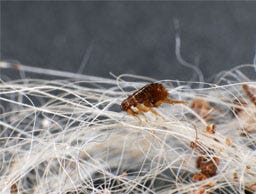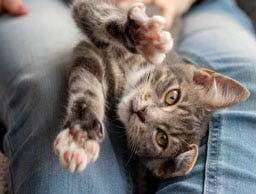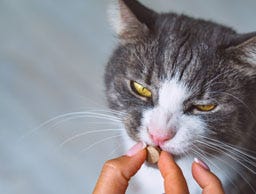Cat Flu: Causes, Symptoms & Treatment
Even the healthiest of cats are susceptible to illness, including the flu. That’s not to say if you have the flu, you might pass it on to your cat. In fact, many of the viruses that cause flu symptoms in humans haven’t been proven to be zoonotic (passable between humans and animals), but there is still a chance your cat might pick up what is commonly referred to as Cat Flu.
In this blog, we’re going to talk you through the symptoms and causes of cat flu and what you can do to treat a cat suffering from cat flu.
What is Cat Flu?
Cat flu is the term given to a common upper respiratory infection in cats. This infection is highly contagious, so can easily be passed between cats inside and outside of the home. It’s almost like a cat’s version of the common cold and can be caused by a number of other viruses, bacteria or existing conditions, most notably:
- Feline Herpes Virus
- Feline Calicivirus
While a common illness, cat flu is most likely to occur in cats that are very young, very old, or have a compromised immune system (such as cats diagnosed with FIV). In these cases, cat flu can have a catastrophic effect on your cat’s health to the point of being life-threatening. That’s why it’s essential you recognise the signs of cat flu in your cat as soon as possible.
Symptoms of Cat Flu
Cats suffering from cat flu tend to show symptoms associated with a cold or flu in humans, including:
- Coughing and sneezing
- Runny nose and eyes
- Sleeping more than usual
- Not eating as much
- Fever
- Mouth ulcers
These symptoms are also found in a number of other conditions, so it’s essential you contact your vet as soon as possible for a professional diagnosis.

How Long Does Cat Flu Last?
As with most viruses, the recovery time depends on what bacteria or virus caused the infection in the first place, as well as your cat’s immune system strength. Healthy cats with a strong immune system may be able to recover from a mild case of cat flu within 5-10 days, while more severe cases can last up to 6 weeks.
If your cat has another condition, such as one of those mentioned above, then it is possible they will struggle with cat flu for the rest of their life, with bouts of symptoms occurring during times of stress or when their immune system is compromised.
Cat Flu in Kittens
Due to their still-developing immune systems, kittens are highly susceptible to cat flu and, due to the contagious nature of the infection, can quickly infect their litter mates. The virus may also be passed from an infected mother to her litter, which can either infect the kitten or lead to them being a symptom-free carrier.
It takes two weeks for the symptoms of cat flu to become apparent, so if you find your cat hasn’t responded to their vaccinations, it’s likely because they were infected prior to their treatment.
Cat flu can be detrimental to the health of kittens, causing permanent damage to their immune systems and ulcers that can damage their eyes.
Cat Flu Treatment
Sadly, there is no cure for cat flu, so treatments for cat flu instead combat the main symptoms of the infection to provide your cat relief. These treatments can include:
- Antibiotics
- Antiinflammatories to reduce inflammation and reduce fevers
- Medications to loosen or break up snot (also known as mucolytics) to aid in easier breathing
- Eye drops if your vet suspects an eye infection as well.
Cat Flu Vaccination
The best way to protect your cat from cat flu is through vaccination. These can be administered by a vet to kittens from 8-9 weeks old to help stave off cat flu or (if your cat has had cat flu before) help reduce the symptoms in future.
The cat flu vaccination is aimed at preventing the feline herpes virus and feline calicivirus, which are thought to cause 80% of cat flu cases. After the primary treatment course, your cat will also need annual boosters to help prevent these viruses.
Please note that, as with human viruses, there are many strains of cat flu that can affect your cat, and not all of them can be prevented by the vaccine. Ensuring your cat is healthy and up to date with all their routine healthcare is essential to maintaining a healthy immune system to fend off this and other viruses.
Cat Flu Treatment at Home
No matter how severe the infection, you can also make some adjustments to help treat your cat’s cat flu at home. Some of the things you can do include:
- Using an air humidifier —this can help open the nasal passages. You could also have your cat join you in the bathroom when you shower to allow the warm steam to do the same.
- Switch to softer, stronger-smelling foods — Sore throats and poor sense of smell can make eating uncomfortable for your cat, so choose a wet cat food that smells strong and easy to chew.
- Wash their face with a warm washcloth — this can remove any of the gunk that might grow crusty around their nose and eyes to help them feel better and prevent any other discomforts.
- Use Repiratory supplements for cats, such as this Flumax Pump Respiratory Supplement to help ease their flu-like symptoms.
Everyone gets sick sometimes, even our pets. Make sure you’re doing all you can to keep your cat’s body and immune system in fighting shape with our great range of cat healthcare products, including top-of-the-range cat foods as well as vitamins and supplements.
This post is an opinion and should only be used as a guide. You should discuss any change to your pet’s care or lifestyle thoroughly with your vet before starting any program or treatment.






























